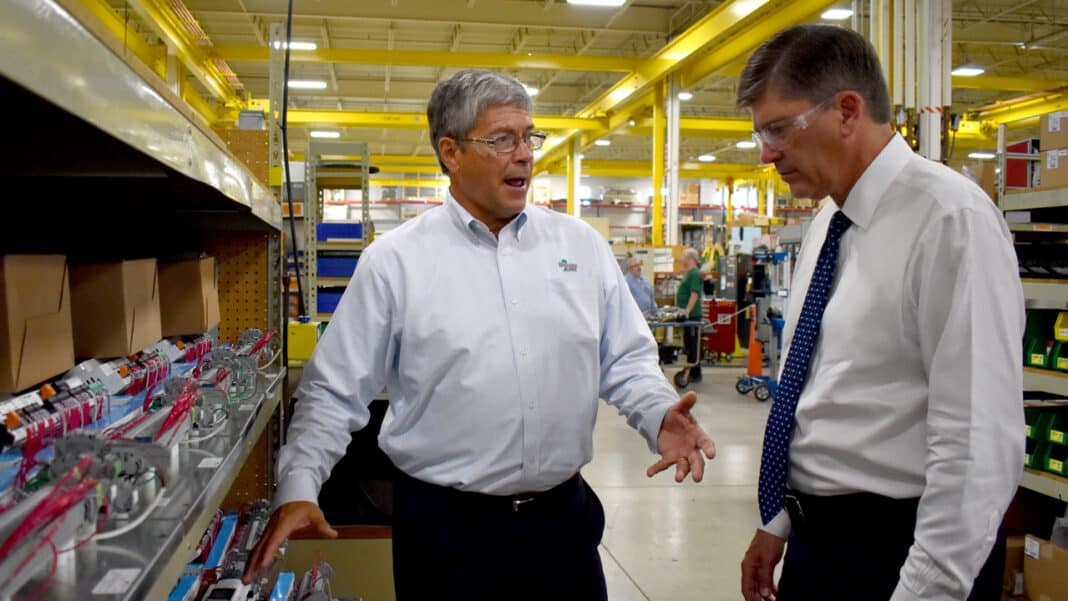Businesses – particularly manufacturers – like certainty. The tariffs and trade actions of the past year, however, have provided anything but certainty.
“As a manufacturer, we need to have that long-term horizon pretty well defined if we’re going to make the right decisions on products, vendors (and) markets that we’re going to go to,” said Keith Coursin, president of Germantown-based Desert Aire LLC.
Coursin’s company makes large dehumidifiers used for pools and indoor growing operations. Increasing prices for steel and aluminum have hit the company particularly hard.
“It becomes a major problem, and the decisions that you make are do you raise the price to cover the cost or do you lower your profit?” Coursin said. “I’ll be honest, neither one’s a good decision.”
Desert Aire has found a niche in areas with legalized marijuana production, making Canada an important market. The company is hoping the pending United States-Mexico-Canada Agreement will bring stability and recently hosted Peter Davidson, general counsel for the U.S. Department of Commerce, for a discussion on the deal.
Davidson highlighted the agreement’s sections on agriculture, intellectual property protections and digital economy issues as improvements on the North American Free Trade Agreement.
“Getting this into effect quickly, I’ve been hearing from a lot of businesses is really important for them,” he said. “They need the certainty to know that these provisions are going to be in place in the near future.”
“I always look at these trade agreements, because we’re such a small player, you kind of take the whole thing as its entirety that this is a good thing, this is a stabilization item. I’m supporting it. We need that,” Coursin said.
He added that it’s also important for there to be a clear goal in all the trade negotiations the administration has taken on.
“Some of the problem we see here is, yeah, I know I support it but what am I actually supporting in the end game when I look five years out, 10 years out? No one’s defining that,” Coursin said.
The Trump administration has introduced or threatened a number of tariffs, including on China, foreign steel and aluminum, and Mexico over immigration. Many of the actions have also prompted retaliation.
The escalating tariff environment is now showing signs of creeping into the manufacturing sector. Exports from Wisconsin decreased 3.9% in the first five months of the year, a $371 million decline led by lower sales to China and Canada.
The Milwaukee-area PMI, part of the Marquette-ISM Report on Manufacturing that measures manufacturing activity in the region, trended down for the past year and dipped into negative territory in May for the first time in 31 months. The index, however, rebounded in June and respondents have maintained a positive outlook for the next six months.
Wisconsin and metro Milwaukee have both averaged year-over-year job growth of less than 1% for the first five months of the year. The number of hours worked by production workers is down 3.3% statewide to start the year. The Milwaukee area has averaged a slight increase, but May saw a 1.6 hour-per-week drop.
Statewide production wages are up an average of 3.7% for the year, but in metro Milwaukee, production wages have averaged a 1.4% decrease.
George Bureau, vice president of consulting services for the Wisconsin Manufacturing Extension Partnership, said most manufacturers remain busy despite some softening early in the year.
“Most manufacturers view that as something temporary,” Bureau said, noting that many companies see the tariffs and trade conflict as positioning to reach a larger deal.
“We saw with Mexico, for example, that was done to create a certain outcome which at least currently looks like it may be successful, so I think there’s a belief that some of this stuff will blow over in time,” Bureau said.
He added that now is a good time for companies to optimize their operations.
“Make those difficult decisions now versus just kind of ride the wave, because it will cycle, somewhere we’ll see lower activity, maybe a contraction down the road, who knows when, but this is the time to make yourself stronger so you’re ready for when that comes,” Bureau said.
A recent national survey by the Chicago-based accounting and advisory firm Sikich LLP found nearly two-thirds of manufacturers are preparing for a recession. The survey also found just 27% expect a recession to occur in the next 12 months.
Around 49% of larger firms – those with more than $500 million in revenue – expect a recession, compared to just 21% of smaller firms, the survey found. Sikich said 12% of the survey’s respondents were Wisconsin companies.
Among companies preparing for a downturn, the most common actions included increasing production efficiency, increasing the ability to quickly scale operations up or down, and exploring new geographic markets.
“The pain of 2008 and the Great Recession is still pretty vivid in the minds of most business owners and management teams, and they learned a great deal from that experience,” said Jerry Murphy, partner-in-charge for Sikich’s manufacturing and distribution services. “Preparation for an eventual slowdown, they know how to do (that) effectively and they’re taking steps so they don’t get caught off guard.”


